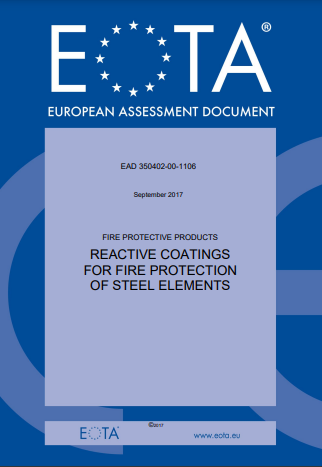Combustibility groups and classes
 According to EAD 350402-00-1106 "Reactive coatings for fire protection of steel elements" the fire protective coatings are assessed for the following use scenario when applied:
According to EAD 350402-00-1106 "Reactive coatings for fire protection of steel elements" the fire protective coatings are assessed for the following use scenario when applied:
- Type X: Fire protective coating products/kits intended for all climatic conditions (internal, semiexposed and exposed to weather)
- Type Y: Fire protective coating products/kits intended for internal and semi-exposed conditions. "Semi-exposed" includes temperatures below 0 °C, but no exposure to rain and limited or casual exposure to UV (but the effect of UV exposure is not assessed)
- Type Z1: Fire protective coating products/kits intended for internal conditions with humidity equal to or higher than 85 % RH, excluding temperatures below 0° C
- Type Z2: Fire protective coating products/kits intended for internal conditions with humidity lower than 85 % RH excluding temperatures below 0 °C
Products/kits that meet the requirements for type X, meet the requirements for all other types. Products that meet the requirements for type Y, also meet the requirements for types Z1 and Z2. Products that meet the requirements for type Z1, also meet the requirements for type Z2.
Fire reaction classes:
- A1: Will not contribute to ignition or spread of flame (not combustible)
- A2: Will not significantly contribute to ignition or flame propagation (highly flammable)
- B: flammable but no risk of ignition (or flammable but self-extinguishing)
- C: May ignite on prolonged exposure to fire
- D: May ignite in a shorter amount of time
- E: May ignite rapidly
- F: does not require testing.
Evaluation of smoke emission during combustion:
- S1: Emissins absent or very little
- S2: Emissions with averadge volume intensity
- S3: Emissions with high volume intensity.
Burning droplets:
- d0: No burning droplets
- d1: Slow dripping dropplets
- d2: High/intense dripping droplets.
The test methods for reaction to fire according to EN 13501-1:
- Non-combustibility test (EN ISO 1182). This test identifies products that will not, or not significantly, contribute to a fire, regardless of their end use. The test is relevant for the classes A1, A2, A1fl, A2fl, A1L та A2L.
- Heat of combustion test (EN ISO 1716). This test determines the potential maximum total heat realise of a product when completely burning, regardless of its end use. The test is relevant for the classes A1, A2, A1fl, A2fl, A1L та A2L. It allows the dermination of both the gross heat of combustion (PCS), and the net heat of combustion (PCI).
